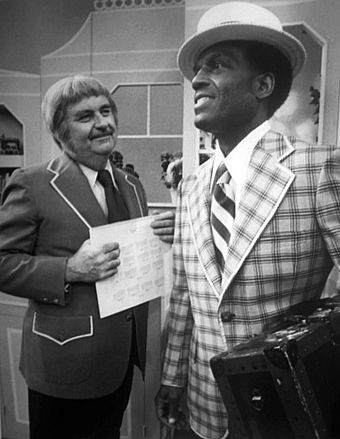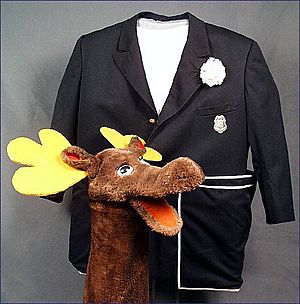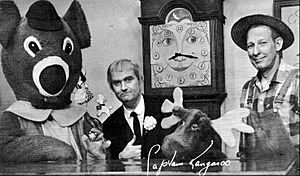Captain Kangaroo facts for kids
Quick facts for kids Captain Kangaroo |
|
|---|---|

Captain Kangaroo (Bob Keeshan), left, with Nipsey Russell, 1976
|
|
| Created by | Bob Keeshan |
| Written by | Howard Friedlander |
| Starring | Bob Keeshan Hugh Brannum |
| Opening theme | "Puffin' Billy (The Captain Kangaroo Theme)" (1955–1974) "Good Morning, Captain" (1974–1984) |
| Country of origin | United States |
| No. of seasons | 29 |
| No. of episodes | 6,090 |
| Production | |
| Running time | 60 minutes / 30 minutes |
| Release | |
| Original network | CBS |
| Original release | October 3, 1955 – December 8, 1984 |
Captain Kangaroo was an American children's television series that aired weekday mornings on the American television network CBS for 29 years, from 1955 to 1984, making it the longest-running nationally broadcast children's television program of its day. In 1986, the American Program Service (now American Public Television, Boston) integrated some newly produced segments into reruns of past episodes, distributing the newer version of the series on PBS until 1993.
The show was conceived by Bob Keeshan, who also played the title character "Captain Kangaroo", and who based the show on "the warm relationship between grandparents and children". Keeshan had portrayed the original Clarabell the Clown on NBC's The Howdy Doody Show during its early years. Captain Kangaroo had a loose structure, built around life in the "Treasure House" where the Captain (the name "kangaroo" came from the big pockets in his coat) would tell stories, meet guests, and indulge in silly stunts with regular characters, both humans and puppets. Keeshan performed as the Captain more than 9,000 times over the nearly 30-year run of the show.
The May 17, 1971, episode had two major changes on the show: The Treasure House was renovated and renamed "The Captain's Place" and the Captain replaced his navy blue coat with a red coat. In September 1981, CBS shortened the hour-long show to a half-hour, briefly retitled it Wake Up with the Captain, and moved it to an earlier time slot; it was moved to weekends in September 1982, and returned to an hour-long format. CBS cancelled Captain Kangaroo at the end of 1984.
Contents
Cast
- Bob Keeshan as Captain Kangaroo, Mr. Pennywhistle, Mr. Doodle, Wally and the Town Clown
- Hugh "Lumpy" Brannum as Mr. Green Jeans, the New Old Folk Singer, Percy, Uncle Backwards, Mr. McGregor, and Mr. Bainter the Painter
- Cosmo Allegretti appeared as Mr. Bunny Rabbit and Mr. Moose (both of which he also created), Dennis the Apprentice, Willy, Miss Frog, Mr. Whispers, Dancing Bear, Grandfather Clock, and Uncle Ralph; he was the voice of Aniforms puppet TV Fred (a live-action on-screen puppet that appeared behind the blackboard in the Treasure House), and was the artist behind the Magic Drawing Board
- Sam Levine as The Banana Man; the character was created by Adolph Proper
- Bill Cosby as himself, the host of the Picture Pages segment (1980–1984)
- Debbie Weems appeared as Debbie (1973–1978); the voice for the puppet character Baby Duck
- James Wall as Mr. Baxter (1968–1978)
- Carolyn Mignini as Kathy and other female roles (1981–1983)
- Kevin Clash as the puppet character Artie (1980–1984) and as himself, acting in many of the sketches
- John Burstein as Slim Goodbody (1978–1981)
- Bill McCutcheon as Mr. Homan (1965–1968)
- Jane Connell as Mrs. Homan (1965–1968)
- Dr. Joyce Brothers as herself for three seasons
Format

The show did not have a strict format, other than the entire program taking place in and around the Treasure House or the Captain's Place, where the Captain would interact with puppets, guests, or other members of the cast. Even the opening sequence could change. The show generally began with the theme music starting up, then the Captain would unlock and open the doors of the Treasure House from the inside, and viewers would catch their first glimpse of him. Then he would put the Treasure House keys on a nail, and the music would stop. However, sometimes the Captain could not get the keys to stay on the nail, and when they fell off, the theme music would begin playing again.
One never knew exactly what would happen from one episode to the next, although at certain times of the year, such as the Christmas season, paper cutout versions of such stories as The Littlest Snowman would be shown.
Cartoons
Several cartoon shorts were featured over the course of the series' run, including:
A cartoon starring a funnel-capped shape-shifting boy named Tom Terrific was part of the show in the 1950s and 1960s. Tom had a sidekick named Mighty Manfred the Wonder Dog, and a nemesis, Crabby Appleton ("I'm rotten to the core!"). Other cartoons included Lariat Sam, who (aided by his loyal horse Tippytoes), confronted his nemesis Badlands Meanie, which was developed by veteran game show announcer Gene Wood, then a show staffer (who also sang the cartoon's theme song).
The British cartoon Simon in the Land of Chalk Drawings appeared in the 1970s, featuring a child with magic chalk who could create all sorts of short-lived creations in short adventures (the original version featured a British narrator, Bernard Cribbins, but Keeshan's voice was dubbed onto the cartoons for their U.S. airing).
Another British-produced cartoon, Ludwig, about a magical egg-shaped robot, was also included around the same time as Simon. The cartoon's musical score consisted of selections from the works of Beethoven.
Also appearing in the 1970s was The Most Important Person, a series of five-minute segments on the importance of life, and The Kingdom of Could Be You, a series of five-minute segments on the importance of careers and the work world.
The cartoon series called The Toothbrush Family was based on an extended family of hygiene utensils, as the name suggests; they would embark on adventures based in the bathroom, like water skiing in the tub, or rescuing friends caught in the drain. Episodes were generally a few minutes each and basically revolved around teaching children the importance of dental care.
A silent cartoon in the 1970s named Crystal Tipps and Alistair featured the adventures of a young girl and her dog. Later reruns were narrated by the voice of Mr. Moose. Another British favorite, The Wombles, was also featured.
The Red and the Blue shorts from Italy were also shown.
The Undersea Adventures of Captain Nemo, featuring a family of sea explorers, was featured, as well.
"Good morning, Captain!"
Beginning in 1974 and continuing throughout the rest of the 1970s and into the 1980s, the show opened with different people wishing the Captain "good morning". Many of the openings featured noncelebrities, but some featured stars from TV shows, most of which broadcast over CBS, such as The Bob Newhart Show, The Price Is Right, Match Game, M*A*S*H, Alice, and One Day at a Time, as well as characters with a connection to another network; including William Shatner and Leonard Nimoy, dressed as Captain Kirk and Mr. Spock, characters from the Peanuts cartoons, Big Bird from Sesame Street, and Fred Rogers from Mister Rogers' Neighborhood. The montage of "good mornings" always ended with the Captain himself returning the greeting before the opening credits.
Regular features
Other regular features included The Magic Drawing Board and the Captain's "Reading Stories" sessions, which introduced kids to stories such as Curious George, Make Way for Ducklings, Stone Soup, Caps for Sale, and Mike Mulligan and His Steam Shovel. The Sweet Pickles books were also featured.
Songs included "Captain Kangaroo", "The Captain's Place", "Little Mary Make Believe", "Dennis Anyone", "Guess Who I Am", "Little Black Frog", "How Does the Jelly Get in the Donut", "There's a Hole in the Bottom of the Sea", "Erie Canal", "Horse in Striped Pajamas", "The Littlest Snowman", "Daniel the Cocker Spaniel", "You Can Grow Up to Be President", "Spend Some Time With Your Child", and many more. Carmino Ravosa was a songwriter on the show from 1975 to 1977. Some well-known songs would be interpreted by puppet characters, such songs as "Minute Waltz", "Supercalifragilisticexpialidocious", "On the Good Ship Lollipop", "Yellow Submarine", "I Love Onions", et al. The show also introduced young viewers to actual rock songs, accompanied by proper film or videotaped footage or puppet action, with such songs as "I'm A Train" (Albert Hammond), "Celebrate" (Kool and the Gang), "Private Eyes" (Daryl Hall & John Oates), et al. On the first show of every month, the Captain had a birthday cake for all of the children with birthdays that month.
Keeshan also had a recurring role as the Town Clown, a pantomime piece that took place in and around the exposed wagon home of a tramp-like circus clown. Like the character Clarabelle that he played on Howdy Doody, the Town Clown never spoke.
Favorite characters on the show were Grandfather Clock (voiced by Cosmo Allegretti), Bunny Rabbit, Rollo the Hippo, and Dancing Bear. Dancing Bear was mute and only appeared in short subject features. He often danced waltzes to background music.
One of the show's long-running gags was the "Ping-Pong Ball Drop", instigated by the telling of a joke (usually a knock-knock joke) by Mr. Moose, in which the punchline included the words "ping-pong balls". At the mention of those three words, a shower of ping-pong balls was released from above on the Captain.
The show often had simple black light theatre segments using paper or cardboard cutouts. A notable recording of a popular song, such as Judy Garland's Decca recording of "Over the Rainbow" (from The Wizard of Oz), Mary Martin singing "Never Never Land" (from the original cast recording of the musical Peter Pan), or Danny Kaye singing "Inchworm" (from the Decca recording of the songs from Hans Christian Andersen) were heard while the cutouts played on the screen, animated by a concealed puppeteer. On other occasions, full-fledged hand puppets "performed" to the song being played (as in the case when a hand puppet dressed in Spanish clothing performed to a recording of tenor Allan Jones singing "The Donkey Serenade").
Also, about two or three times in an episode, short film clips on certain topics played over a song about that particular topic.
Especially in later seasons, the show also featured a running gag where on selected episodes, the Captain would try to perform a particular activity three or four times in the episode, only to fail in a different way on each attempt.
Familiar props included a mockup of a talking cathedral-style radio that Keeshan simply called Radio. Keeshan would turn the large knobs on Radio to get a conversation going. Reminiscent of the old Atwater Kent cathedrals, Radio had a rather interesting conversation with a smaller transistor radio in one show. Also featured was a huge Colgate toothpaste box with a large windup or clockwork key on the side. Keeshan turned the key to play a jingle ("Colgate Fluoride M-F-P/Helps Prevent the Cavity/And it Tastes Great, Naturally!") for the show's sponsor, Colgate Toothpaste.
At the end of each episode, the Captain always encouraged parents watching the show to spend some quality time with their children every day, and he often demonstrated various creative ways in which to do so. In later seasons, that changed to him saying, "Well, what would you like to do today? You know it could be a good day for..." then a song would list many different activities while short film clips of each corresponding activity are presented, then the song ended with the singers saying, "There's so much to do. These things are just a few." Then it would cut back to the Captain, who would sign off with, "So whatever you do, have a great day!"
Theme song
The original theme song to Captain Kangaroo (titled "Puffin' Billy") was used from 1955 to 1974. It was an instrumental piece of light music, written by Edward G. White and recorded by the Melodi Light Orchestra. The track was from a British stock music production library known as the Chappell Recorded Music Library, which was sold through a New York agency called Emil Ascher. The tune's original title referred to a British steam locomotive. The tune was used on various programs on both sides of the Atlantic and was already popular in the United Kingdom: for example, two years before Captain Kangaroo, it served as the wrap-up music for an episode of the radio program Rocky Fortune called "Murder Among the Statues". In the United Kingdom, it became famous as the theme to the weekly BBC radio program Children's Favourites from 1952 to 1966, and is still widely recognised by the postwar generation. It was later used in the Enid Blyton parody Five Go Mad in Dorset and in a number of British TV advertisements, including a Captain Sensible spot. The "Puffin' Billy" theme played as the opening of each episode, with the music continuing until the Captain hung his large ring of keys on a nail (which seemed to act as a switch to turn off the music). If the Captain's keys ever slipped off the nail, the music began playing again. In 1957, lyricist Mary Rogers penned lyrics to the tune, creating a newly titled Captain Kangaroo song.
In 1974, a new theme song titled "Good Morning, Captain" was composed for Captain Kangaroo, written by Robert L. Brush. As the new theme used similar melodic elements from the original theme, Edward G. White's name was added to the song credits. However, due to copyright issues, the song was re-recorded in 1979 without the portion of "Puffin' Billy" featured in the first version.
During the brief Wake Up With the Captain era, a theme titled "Wake Up" was used, but was dropped after the program moved to weekends, when the second version of "Good Morning, Captain" was reinstated.
For the show's later seasons from 1982-1984 and subsequent PBS run, Schoolhouse Rock mainstay Lynn Ahrens (who composed and performed a few Captain Kangaroo songs herself) wrote a new theme, entitled "Here Comes Captain Kangaroo".
The theme song for All New Captain Kangaroo used the opening notes and part of the melody of the original theme as its introduction.
Bob Keeshan also recorded music for both Columbia Records and Golden Records, aimed at introducing all kinds of music to children.
1997 reboot
In 1997–1998, a rebooted series titled The All New Captain Kangaroo was produced by Saban Entertainment in association with TLC Entertainment. Eric S. Rollman, who also served as President of Saban and Fox Family Productions, was executive producer. George Taweel and Rob Loos of TLC produced the series. John McDonough played the Captain on this version, which was shot in Tampa, Florida and featured animal segments shot at Busch Gardens Tampa Bay and Seaworld in Orlando. Keeshan was invited to appear as a special guest called "The Admiral", but declined. Thirteen episodes were produced for syndication with an additional twenty-seven episodes served as the centerpiece for a programming block on The Family Channel (later known as Fox Family Channel) dubbed Captain Kangaroo's Treasure House, from 1997 to 2000; the block also featured reruns of Thomas the Tank Engine and Friends and Magic Adventures of Mumfie, as well a spin-off show, Mister Moose's Fun Time, which included cartoon segments from around the world. When Disney bought Fox Family the company shelved The All New Captain Kangaroo and Mister Moose's Fun Time, allegedly due to the fact the reboot advertised Busch Gardens & Seaworld, rivals of Walt Disney World.
In 2011, the trademark for Captain Kangaroo was acquired by the Cashin Comedy Co. In a blog, the Captain is portrayed by Pat Cashin, an entertainer and professional clown. Cashin died in 2016 at the age of 48, leaving the rights to the character with his estate.
Images for kids




